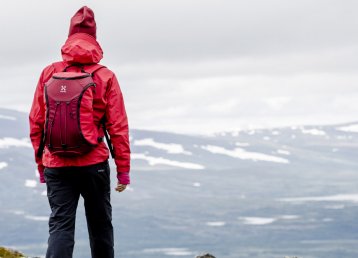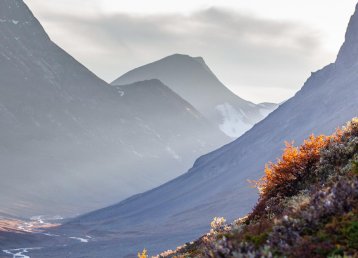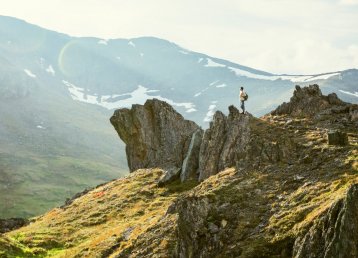It’s a Friday afternoon. Tired after the working week, we’re sat in the office giggling at everything and nothing, Åsa and I. We turn our computer screens to avoid the glare from the autumnal sun shining in through the window. At the same time, we complain about being stuck inside on such a beautiful day.
– Let’s go to the mountains instead! I hear myself saying.
– Let’s pack a rucksack and just go.
– Yes. Let’s do it, Åsa says with determination.
Towards Abisko
From word to action in no time: a couple of final, quick e-mails, impatient feet tapping, waiting for the computers to shut down, a quick sprint out the front door. Home to pack some necessities: warm clothes, comfortable walking boots, a flask, a camera and a spare hat. It’s very simple, as we all know: “If your feet are cold — put your hat on”. The following morning we’re sat in the car heading for Abisko.
Suitably, it’s lunchtime as we enter STF Abisko Turiststation with our stomachs rumbling. The restaurant serves exclusively food that’s been awarded the Swedish KRAV-label, and we both enjoy a big bowl of tasty salmon soup served with freshly made bread. The view rewards us with a cloudy Torneträsk and a mountain-birch forest that’s alive with colours. I add a photo of the view to my Instagram account and instantly get comments about how beautiful Abisko is. “I love that place! Especially in winter”, writes an Australian photographer I know. He has obviously never been here in autumn.
The season of colours
Once we’ve had our fill we’re happy to lace our boots, fill our flasks with coffee and aim for Abisko Canyon, about 100 metres from the tourist station. The canyon is 20 metres deep with steep slate and dolomite walls. At the bottom of the canyon, the free-flowing Abiskojåkka/Ábeskoeatnu mountain stream finds its way from lake Abiskojaure to Torneträsk.
I fill my lungs with fresh air that has a cool edge to it. Not many days now until the first night’s frost. Not a mosquito in sight. We walk on footbridges alongside the steep cliff wall, but only make it a few metres at the time before we have to stop and reach for the camera. Even more beautiful scenery presents itself at every turn.
We call this time of year autumn, which makes it feel a bit miserable — like something heavy, better captured by Ingmar Bergman in a black-and-white film. But it’s very unfair in so many ways. The Sámi who lives here calls this time of year ruski. And our neighbours to the East call it ruska. This means they speak of a concept: ‘the season of beautiful colours’. Because during autumn the air is clear, you can see far and wide, not much interrupts you, and if you’re lucky, you will also experience the season’s first encounter with Aurora Borealis.
Coffee break
We follow the canyon all the way to the beach where Torneträsk extends along with grey and blurred mountain outlines. A slow autumn rain descends over the lake. And it’s so beautiful. The beach goes on for kilometres without any trace of visitors; there is nothing here other than an immense view, the autumn wind tugging at your hair and a faint scent of rain.
– This calls for a cup of coffee, Åsa tells me and produces her flask.
Several hours later we arrive at the Abisko Mountain Lodge, wet and ruffled. We’ve rented a room here for the night. After a quick shower and change, we reverently enjoy a two-course meal made from local produce and finish it off with homemade truffles and cognac. But even though our bodies are now warm and tired, we put our walking boots back on, pack our cameras and head out into the darkness. We’ve heard rumours about northern lights.
And then, the northern lights
It’s not hard to understand why Abisko is so popular among northern light tourists. Apart from a microclimate that keeps the sky free from clouds, there’s almost no artificial light here to distract. Without the snow, it’s very, very dark outside — ideal for a northern light tourist.
With only the moon to light our path, it’s a miracle we find our way to Torneträsk and the little jetty in Abisko Östra. The wind has picked up now and whips up black waves along the edge of the beach. The flimsy tripod refuses to stand properly.
– There! Can you see it? Northern lights!
A thin, green veil slowly sweeps across the dark night sky. The camera ticks away as I eagerly try to capture the elusive glow that promptly disappears and doesn’t return. After spying for a while, we admit defeat. We might not have any photos of the northern lights but are still happy to have crammed so much into this day.
A year later, I’m sitting in front of my computer screen again. The autumn sun shines in. I look at the photos and feel how my lungs are craving that fresh, cool autumn air. I simply have to go home and pack my rucksack. Again.
Learn more
You can easily travel by train to Abisko, the night train goes all the way from Stockholm. Visit vy.se for more information. You can also take a bus from Kiruna and during winter, there are taxi- and transfer services available (contact your accommodation for recommendations). To learn more about STF Abisko Turiststation, visit the Swedish Tourist Association’s website. Abisko Mountain Lodge you can find at abiskomountainlodge.se.


























